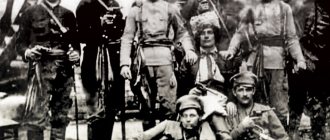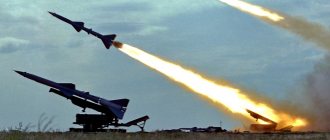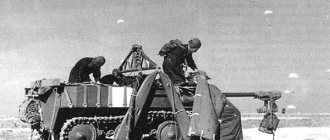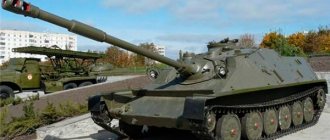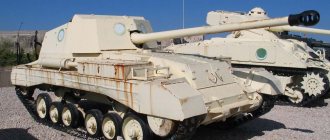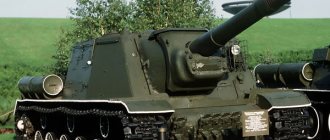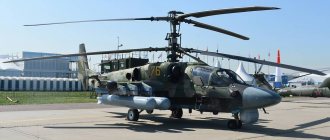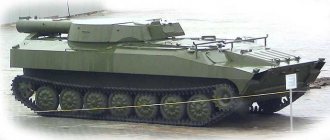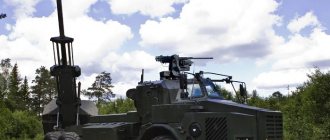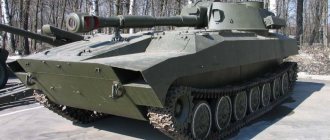| ZPU-2 (56-US-562) | |
| |
| Type: | Towed anti-aircraft gun |
| A country: | |
| Service history | |
| Years of operation: | since 1949 |
| In service: | [sn 1] |
| Wars and conflicts: | Gulf War |
| Production history | |
| Constructor: | Plant No. 2 |
| Designed by: | from 1944 to 1949 |
| Manufacturer: | Plant No. 525 |
| Years of production: | since 1944 |
| Total released: | more than 370 |
| Options: | ZPU-2, Type-58 |
| Characteristics | |
| Weight, kg: | 1000 |
| Ground clearance, mm: | 380 |
| Main weapons: | 2 x 56-P-562 |
| Length, mm: | 3710 |
| Barrel length, mm: | 1346 |
| Width, mm: | 1900 |
| Height, mm: | 1925 |
| Crew (crew), people: | 6 |
| Cartridge: | 14.5×114 mm |
| Caliber, mm: | 14,5 |
| Work principles: | short barrel stroke, rotary bolt |
| Rate of fire, rounds/min: | 1100..1200 |
| Initial bullet speed, m/s: | 990..1000 |
| Maximum range, m: | 2000 |
| Type of ammunition: | tape |
| Aim: | PU, K-10T |
| Images on Wikimedia Commons: | ZPU-2 (56-US-562) |
ZPU-2ZPU-2
ZPU-2
(GAU index -
56-US-562
) - Soviet coaxial anti-aircraft machine gun mount.
History of creation
The development of a coaxial anti-aircraft machine gun mount was started on a competitive basis at Plant No. 2. In November 1944, the first sample of the design by S.V. Vladimirov and G.P. Markov was manufactured. In 1945, the sample underwent comparative tests with an installation designed by F.V. Tokarev. According to the test results, the design of S.V. Vladimirov was recognized as better. After eliminating the comments and modifications, in 1948 the prototype passed field and military tests. In 1949, ZPU-2 was put into service. Serial production was launched at Plant No. 525[1][2].
Text of the book “Combat and service weapons of Russia”
Single anti-aircraft machine gun mount ZPU-1
The decision to create an anti-aircraft machine gun mount based on the 14.5 mm machine gun of S.V. Vladimirov was made in April 1944, shortly after the successful completion of field tests of this machine gun. In June 1944, the installation was presented for field testing, but its characteristics did not satisfy the military and work on the installation was stopped.
In 1947, the Scientific and Technical Committee of the Main Artillery Directorate approved the tactical and technical requirements for the development of a new anti-aircraft machine gun mount for the Vladimirov machine gun. In accordance with these requirements, the installation had to ensure the destruction of high-speed enemy aircraft flying at an altitude of up to 1500 m. The installation was designed on a competitive basis by several teams of designers from the Kovrov Union Plant No. 2. The first two projects were considered unsuccessful. In March 1948, four projects for anti-aircraft machine gun mounts for the Vladimirov machine gun were presented to the testing commission for consideration. The project of E. D. Vodopyanov and E. K. Rachinsky was recognized as the best. On its basis, in the same year, a technical design for the installation was developed and a prototype was manufactured. The work was carried out at a fast pace: the installation passed field and military tests in the same 1948, and it was adopted by the Soviet Army in 1949 under the designation “14.5 mm single anti-aircraft machine gun mount ZPU-1.”
ZPU-1 was launched into serial production in 1949.
The ZPU-1 anti-aircraft machine gun mount consists of a 14.5 mm KPV machine gun, a light carriage, wheel travel and sighting devices.
The KPV machine gun has automatic reloading mechanisms, the operation of which is based on the principle of using recoil energy with a short barrel stroke. The rate of fire is 550 rounds/min, the combat rate of fire reaches 150 rounds/min.
The ZPU-1 carriage consists of upper and lower machines. The carriage provides all-round fire with elevation angles from –8 to +88°.
On the top of the carriage there is a seat on which the gunner sits during firing. The lower machine of the carriage is equipped with a wheel travel, allowing the installation to be towed by light army vehicles. When the installation is transferred from the traveling to the combat position, the wheels of the wheel drive are rotated to a horizontal position. A combat crew of 5 people transfers the installation from a traveling position to a combat position in 12–13 seconds.
The lifting and rotating mechanisms of the carriage ensure that the weapon is aimed in the horizontal plane at a speed of 56 degrees/s; in the vertical plane, guidance is carried out at a speed of 35 degrees/s. This allows you to fire at air targets flying at speeds of up to 200 m/s.
To transport the ZPU-1 over rough terrain and in mountainous conditions, it can be disassembled into separate parts and transported (or carried) in packs weighing up to 80 kg.
In general, the design of the carriage is highly manufacturable; all its parts are made by stamping and welding.
The ammunition used for the installation is an extremely powerful 14.5x114 mm cartridge, which was successfully used during the Great Patriotic War to destroy enemy armored vehicles using anti-tank rifles.
An effective means of destroying air targets with strong armor protection at distances of up to 1000–2000 m are 14.5 mm cartridges with an armor-piercing incendiary bullet B-32 weighing 64 g (GRAU index 57-B3–561, 57-B3–561 s). This bullet penetrates 20 mm thick armor at an angle of 20° from normal at a distance of 300 m and ignites gasoline located behind the armor.
To engage highly protected air targets, as well as for zeroing in and adjusting fire at a distance of up to 1000–2000 m, 14.5 mm cartridges with an armor-piercing incendiary tracer BZT bullet weighing 59.4 g are used (GRAU index 57-B3 T-561 and 57 -B3 T-561 s). The bullet has a cap with a pressed-in tracer compound, which leaves a luminous trace visible at a great distance.
The armor-piercing effect is slightly reduced compared to the B-32 bullet. At a distance of 100 m, the B3 T bullet penetrates 20 mm thick armor placed at an angle of 20° to the normal.
To combat highly protected targets, 14.5 mm cartridges with an armor-piercing incendiary bullet BS-41 weighing 66 g (GRAU index 57-B3–562) can also be used. At a distance of 350 m, this bullet penetrates 30 mm thick armor located at an angle of 20° to the normal.
The installation's ammunition may also include 14.5 mm cartridges with an armor-piercing incendiary-tracer bullet BST weighing 68.5 g (GRAU index 57-B3 T-562), with an instant-action incendiary bullet MD3 weighing 60 g (GRAU index 57-3 -564 and 57–3-564 s), with an incendiary sighting bullet ZP (GRAU index 57–3-561 M).
The cartridges are fed from a metal link belt placed in a cartridge box with a capacity of 150 cartridges.
The ZPU-1 uses an angular collimator anti-aircraft sight as sighting devices.
To provide air defense to motorized rifle units on the march, the design bureau of the Gorky Automobile Plant in 1948 developed the ZPU-1 version on the chassis of the BTR-40 light armored personnel carrier. The anti-aircraft machine gun mount was located in an open top armored turret of circular rotation, mounted on the roof of the troop compartment. This self-propelled anti-aircraft machine gun was not put into serial production.
Twin anti-aircraft machine gun mount ZPU-2
Along with a single ZPU-1 anti-aircraft machine gun mount under one 14.5 mm machine gun of the S.V. Vladimirov system, in the first post-war years in the USSR, the ZPU-2 anti-aircraft machine gun mount was also designed. The installation was a means of air defense for troops and was intended to combat enemy aircraft at altitudes of up to 1500 m. The range of fire was to be 2000 m.
The design of the installation began in 1945. The work was carried out on a competitive basis by designers S.V. Vladimirov (together with G.P. Markov) and F.V. Tokarev.
Surprisingly, prototypes of anti-aircraft machine gun mounts from both groups of designers were presented for comparative tests in the same 1945.
Comparative tests have shown that the installation designed by S.V. Vladimirov and G.P. Markov has the best characteristics. After eliminating the shortcomings identified during the tests, the installation of these designers in 1948 was presented for testing grounds, and then military tests. The installation was adopted into service by the Soviet Army in 1949 under the designation “14.5 mm coaxial anti-aircraft machine gun installation ZPU-2.”
Serial production of the installation was carried out at plant No. 525.
The ZPU-2 installation entered service with anti-aircraft units of motorized rifle and tank regiments of the Soviet Army. Through foreign economic channels, a significant number of installations of this type were exported to many countries around the world.
ZPU-2 consists of two 14.5 mm KPV machine guns, a lower carriage with three lifts, a rotating platform, an upper carriage (with guidance mechanisms, cradle and cartridge box brackets, as well as gunner seats), a cradle, sighting devices and wheel travel .
The lower machine of the carriage is a welded triangular frame on which the upper machine is fixed with the possibility of circular rotation. To ensure transportation of the installation, the lower machine is equipped with a detachable wheel drive. For firing, the installation is removed from the wheels and placed on the ground. Its transfer from traveling to combat position is completed in 18–20 seconds.
Guidance mechanisms mounted on the upper carriage allow all-round firing with elevation angles from –7 to +90°.
The speed of pointing the weapon in the horizontal plane is 48 degrees/s, pointing in the vertical plane is carried out at a speed of 31 degrees/s. The maximum speed of the target being fired is 200 m/s.
The cradle is equipped with a balancing mechanism. It is made in the form of a spiral spring and is located inside the lifting mechanism.
The detachable wheel travel is suspended on leaf springs. This allows the installation to be towed by light military vehicles at a fairly high speed. Over long distances, the installation, ammunition and crew of 6 people are transported in the back of an army truck. Although the mass of the installation with wheels and cartridges reaches 1000 kg, it can be moved over short distances by calculation forces.
The two 14.5 mm KPV machine guns that make up the installation’s armament provide a total rate of fire of 1,100 rounds/min. The combat rate of fire is 300 rounds/min.
Shooting is carried out with 14.5×114 mm cartridges with an armor-piercing incendiary bullet B-32 weighing 64 g, an armor-piercing incendiary bullet weighing 59.4 g, an armor-piercing incendiary bullet weighing 59.4 g, an armor-piercing incendiary bullet weighing 59.4 g, an armor-piercing incendiary bullet weighing BST 68.5 g, instantaneous incendiary bullet MD3 weighing 60 g, incendiary sighting bullet ZP weighing 61 g.
The cartridges are fed from metal link belts placed in cartridge boxes with a capacity of 150 cartridges.
To aim the weapon at the target, an angular collimator sight is used.
In order to increase the tactical mobility of anti-aircraft machine gun units and provide air defense to motorized rifle units on the march in the late 1940s. a ZPU-2 variant was designed, intended for placement on armored personnel carriers. It was designated ZPTU-2.
In 1947, the design bureau of the Gorky Automobile Plant developed the BTR-40 A anti-aircraft installation, which consisted of a light two-axle armored personnel carrier BTR-40 and an anti-aircraft machine gun installation ZPTU-2, located in the troop compartment of the armored personnel carrier. The anti-aircraft installation had a circular fire, and vertical guidance angles ranged from –5° to +90°. The ammunition consisted of 1200 rounds.
The BTR-40 unit was put into service in 1951 and was mass-produced at the Gorky Automobile Plant. Later they created a version of the vehicle with the ability to travel by rail (BTR-40 AZD).
In 1925 at the Moscow Automobile Plant named after. I.V. Stalin launched the production of the BTR-152 A anti-aircraft gun (object 140 A), created on the basis of the three-axle BTR-152 armored personnel carrier with the placement of a twin 14.5 mm ZPTU-2 mount. The installation provided all-round fire, guidance in the vertical plane was carried out in the angle range from –5° to +89°. The ammunition load was 1200 rounds. Until 1955, 719 such units were produced.
Since 1955, the improved BTR-152 E installation based on the BTR-152 B1 armored personnel carrier was put into production. The armament of the self-propelled gun was ZPTU-2. Thanks to the centralized tire pressure regulation system installed on the armored personnel carrier, the self-propelled unit had increased off-road capability.
Air defense units of motorized rifle regiments of the Soviet Army received about 160 vehicles of this modification.
The tracked anti-aircraft machine gun mount based on the BTR-50 P armored personnel carrier was even more capable of cross-country ability.
Several samples of the installation were made, but they did not put it into mass production.
ZU-2 twin anti-aircraft machine gun mount
The adoption of the 14.5 mm ZPU-2 anti-aircraft machine gun mount into service by the Soviet Army in 1949 significantly strengthened the air defense of motorized rifle and tank regiments, but the use of this mount in the airborne troops was difficult due to the significant mass of this mount. For this reason, it was decided to develop a new anti-aircraft machine gun mount for paratroopers with the same firepower as the ZPU-2, but less weight. In 1950, the Scientific and Technical Committee of the Main Artillery Directorate developed tactical and technical requirements for the development of such an installation. The corresponding order was issued to plant No. 525, which, in turn, entered into an agreement for the design of the installation with the NITI-40 enterprise. Developed by a group of designers consisting of E.K. Rachinsky, B.D. Vodopyanov and V.I. Gremislavsky, the installation was presented for field testing in 1952, it had the factory designation UZPU-2. The installation version, modified taking into account the test results, was adopted by the Soviet Army in 1954 under the designation “14.5 mm ZU-2 anti-aircraft machine gun mount.” Serial production of the ZU-2 was organized at plant No. 525 in 1955. In the airborne troops, the ZU-2 was in service with battalion-level air defense units.
A significant number of ZU-2s were exported by the Soviet Union to other countries around the world, where they are still in use today. Since 1960, the ZU-2 installation was manufactured under license in Poland under the designation RKM-2 (Przeciwlotniczy Karabin Maszynowy - anti-aircraft machine gun). Currently, the Polish Army is armed with a modernized anti-aircraft machine gun mount PKMZ-2 (Zmodernizowany - modernized).
In its design, ZU-2 is a further development of the ZPU-1 installation, produced by plant No. 525. The designers’ decision to take the installation already in production as the basis for the new system, one of the creators of ZU-2 E.K. Rachinsky explains this way: “We, being direct participants in putting into production the complex of ZPU-1, ZPU-2 and ZPU-4 installations, were convinced in practice that the design of ZPU-1, which was distinguished by the widespread use of thin-sheet stamping units and parts, provided it with high manufacturability in the production process, and therefore and the idea arose of creating a twin installation based on a single ZPU-1 and unified with it to facilitate production and reduce the cost of products instead of ZPU-2.”
Taking the ZPU-1 as a basis, the designers modified it as follows:
• the cradle of the upper carriage was adapted for mounting two 14.5 mm KPV machine guns;
• to the right of the existing seat, an additional seat was installed for the gunner servicing the sight;
• mounted an additional right frame for installing a second cartridge box;
• redesigned the wheel travel of the carriage. It is made irremovable.
The use of an integral wheel drive, in which, when the installation is transferred to the combat position, the wheels rise above the ground level and do not interfere with horizontal guidance, made it possible to reduce the weight of the ZU-2 in the stowed position compared to the ZPU-2 by 70 kg.
At the same time, such a design solution made it possible to significantly improve the stability of the new installation when firing, since thanks to the integral drive, its mass in the firing position is greater than the mass of the ZPU-2, in which the wheel travel is separated when transferred to the firing position. It should also be noted that, unlike the ZPU-2, the transfer of the ZU-2 from the traveling position to the combat position can be performed by one crew number.
The design of the ZU-2 carriage ensures all-round firing; aiming the weapon in the vertical plane is possible in the angle range from –15° to +90°. The relatively large declination angle allows the ZU-2 to be used in mountainous conditions to fire at ground targets located below the installation level. The guidance mechanisms mounted on the upper machine of the carriage allow the weapon to be aimed in the horizontal plane at a speed of 56 deg/s, and in the vertical plane at a speed of 35 deg/s.
Shooting is carried out with 14.5x114 mm cartridges with bullets for various purposes. The cartridges are fed from metal link belts placed in cartridge boxes with a capacity of 150 cartridges.
In terms of combat effectiveness, the ZU-2 is approximately equivalent to the ZPU-2. It has a maximum rate of fire of 1100 rounds/min, practical rate of fire is 300 rounds/min. At the same time, due to the higher speed of aiming the weapon in the horizontal plane (56 deg/s versus 48 deg/s for the ZPU-2), the likelihood of hitting high-speed air targets has increased.
To a large extent, the increase in the combat effectiveness of the ZU-2 was facilitated by the installation of the ZAP-2 anti-aircraft sight on it, developed by the designers. This sight is a fairly complex mechanical computing device of a high accuracy class and provides the ability to conduct effective fire at air targets flying at altitudes of up to 2000 m at speeds of up to 300 m/s, without limiting the heading angle and dive angle.
The design of the ZU-2 allows it to be transported in various ways. It can be towed by light military vehicles or transported in the back over short distances. On the battlefield, the installation is moved by crew forces, and for transportation in mountainous conditions it can be disassembled into parts weighing no more than 80 kg each.
Quadruple anti-aircraft machine gun mount ZPU-4
The successful use of multi-barreled anti-aircraft guns of 12.7–20 mm caliber by the armies of Germany and the USSR's allies in the anti-Hitler coalition during the Second World War served as an incentive for the creation of such a gun in the USSR. It was intended to combat enemy aircraft at altitudes up to 1500 m and at ranges up to 2000 m. It was decided to design the installation for four 14.5 mm Vladimirov machine guns; the Scientific and Technical Committee of the Main Artillery Directorate developed the corresponding tactical and technical requirements in 1945.
The design of the 14.5 mm quad anti-aircraft machine gun mount was carried out on a competitive basis by teams of designers from the Kovrov Union Plant No. 2 and OKB-43. Comparative tests of the installations of both teams showed the advantage of the Kovrov installation, designed under the leadership of I. S. Leshchinsky. After finalizing this installation based on the results of comparative tests, it was tested at the Donguz test site in 1946, and in August - September 1948 it was subjected to military tests. I. S. Leshchinsky’s installation was adopted into service by the Soviet Army in 1949 under the designation “14.5 mm quadruple anti-aircraft machine gun installation (ZPU-4).” She was given the GAU index 56-U-562.
ZPU-4 was mass-produced and entered service with air defense units of tank and motorized rifle regiments, as well as airborne divisions. It was exported through foreign economic channels to many countries around the world, and in China and the DPRK the installation was carried out under license.
ZPU-4 is the most powerful Soviet anti-aircraft machine gun mount. It consists of four 14.5 mm KPV machine guns, a machine gun with aiming mechanisms, a cart and sighting devices.
The machine consists of upper and lower parts. The upper part of the machine is rotating, it is the basis for the swinging part of the installation. Manual mechanisms are mounted on the top of the machine, providing circular guidance of the installation in the horizontal plane, as well as guidance in the vertical plane in the angle range from –10° to +90°. The guidance speed in the horizontal plane is 48 degrees/s, the guidance speed in the vertical plane is 29 degrees/s.
On the top of the machine there are also gunner seats and cartridge boxes with belts with a capacity of 150 rounds.
The lower part of the machine is attached to the cart and serves as a base for the upper part.
The ZPU-4 cart is similar in design to the cart for the 25 mm anti-aircraft gun mod. 1940. It is made with four wheels, with suspension on each wheel.
The wheel travel does not separate when moving to the firing position. Automotive-type wheels on GC tires filled with sponge rubber. The cart consists of a frame, forward and reverse gears, a mechanism for controlling the cart, suspension, mechanisms for transferring the gun from the traveling position to the combat position and four frames. The forward drive is rotary, serves to change the direction of movement of the unit when towing it, it is pivotally connected to the frame of the cart using a balancer.
To facilitate the transition of the installation from the traveling position to the combat position, special shock absorbers are used, located inside the beam of the cart frame. To transfer the installation from the traveling position to the combat position, the efforts of four people are required, this takes 70–80 seconds.
In a combat position, the cart stands on four frames (supports). Leveling the cart is done using four jacks and levels, allowing the cart to be installed on uneven terrain.
If necessary, firing from the installation can be carried out from wheels, without transferring from the traveling position to the combat position.
The maximum towing speed of the unit on an asphalt highway is 60 km/h, on cobblestone roads – 45 km/h, on a dirt road – 30 km/h, and off-road – 15 km/h.
Over a short distance, an installation weighing 2100 kg can be moved by a crew consisting of 6 people.
The installation's armament consists of four 14.5 mm KPV machine guns with a total rate of fire of 2200 rounds/min. The combat rate of fire is 600 rounds/min.
The ammunition used is 14.5×114 mm cartridges with various types of bullets: B-32 armor-piercing incendiary bullet weighing 64 g, BZT armor-piercing incendiary bullet weighing 59.4 g, BS-41 armor-piercing incendiary bullet, incendiary-tracer bullet BST weighing 68.5 g, instant-action incendiary bullet MDZ weighing 60 g, incendiary-tracing bullet ZP weighing 61 g.
The cartridges are fed from metal link belts placed in cartridge boxes with a capacity of 150 cartridges.
The maximum flight speed of the target being fired is 300 m/s; within a second, the installation can fire up to 36 bullets at the target with a total mass of up to 2.1 kg.
An automatic anti-aircraft sight of the APO-14.5 construction type, developed by TsKB, was used as sighting devices.
During the operation of the ZPU-4, it turned out that due to the non-simultaneous movement of the rolling barrels of machine guns, aiming is sometimes lost when firing, since the data to be entered into the sight is determined by eye and entered manually, the results of shooting largely depend on the training of the crews.
A significant drawback of the installation was the low survivability of its weapon - the KPV machine gun, which, as you know, was developed not as an anti-aircraft machine gun, but as an anti-tank machine gun.
The ZTPU-4 anti-aircraft self-propelled gun based on the BTR-50 P tracked armored personnel carrier was not put into serial production. This unit was developed by the design bureau of the Chelyabinsk Tractor Plant; in 1955, prototypes of the unit underwent field tests. The main reasons for the abandonment of the ZTPU-4 were the large mass of the machine gun mount and the insufficient volume of the airborne squads of armored personnel carriers, which made it difficult for the installation crew to work.
Quite unexpected was the use of ZPU-4 on improvised armored trains operating in the Caucasus during the first and second Chechen campaigns. For example, the OMON "Yastreb" armored train of the Volgo-Vyatka City Internal Affairs Directorate had two such installations. They were fired at ground targets.
Description of design
The main task of the ZPU-2 is to defeat enemy air forces (aircraft, airborne units). It can also be used to fire at lightly armored vehicles, concentrations of manpower and surface units. The installation can be moved over short distances by crew forces[3].
The main components of the ZPU-2 are: machine guns, installation, wheel drive and sighting devices. The wheel drive is designed for towing the ZPU-2 in the stowed position and consists of two wheels with a tubular arc. When the ZPU-2 is transferred to the firing position, the wheel drive is disconnected, and the installation is placed with its base on the ground. On the base there is a shoulder strap with a turntable. On the platform there is a cradle with machine guns[3].
Armament
Coaxial 14.5-mm KPV machine guns are used as weapons. For firing, the ZPU-2 is equipped with manual and foot trigger mechanisms. The range of ammunition includes armor-piercing incendiary bullets B-32 and BS-41, armor-piercing incendiary tracer bullets BZT, as well as sighting and incendiary bullets ZP. The ammunition is placed in two boxes with machine gun belts. Each belt contains 150 rounds of ammunition[3].
Sights
To target air targets, the ZPU-2 is equipped with an anti-aircraft sight, with a K10-T turret collimator installed in the middle of the sighting part. When shooting at ground targets, aiming is carried out through a shortened optical sight PU[3].
ZPU-4 - powerful Soviet anti-aircraft gun
Published by: harlov, 08/28/2016, 19:46, Equipment and weapons, 2,796, 0
The ZPU-4 anti-aircraft machine gun mount
consists of quadruple 14.5 mm KPV machine guns.
One of the copies of this installation is in the Military Historical Museum of Artillery, Engineering Troops and Signal Corps in St. Petersburg. The development of the quadruple installation ZPU-4 was started in 1945 on a competitive basis by plant No. 2 and OKB-43. Preliminary tests of ZPU-4 designed by I.S. Leshchinsky (plant No. 2) showed its advantages over the OKB-43 installation. After modification based on the test results of ZPU-4 I.S. Leshchinsky was retested at the Donguz test site in 1946. In August-September 1948, it passed military tests and was put into service in 1949. The main parts
of the ZPU-4: four 14.5-mm KPV machine guns, a carriage and sighting devices.
Mounted on the upper carriage are a shoulder strap, a swivel, a cradle with four machine guns, frames for cartridge boxes, lifting, rotating and triggering mechanisms, seats for the gunner and sighting gun. The lower carriage machine is equipped with a four-wheel sprung ride. To ensure the necessary stability of the installation when firing, there are screw jacks on which the installation is lowered when transferring it from the traveling position to the combat position. A team of 6 people performs this operation in 70-80 seconds. If necessary, the installation can also be fired from wheels. The ZPU-4
was used during the Korean War by North Korean and Chinese forces, and was considered by the US military to be the most dangerous enemy of helicopters in Vietnam. The ZPU-4 was used by the Iraqi armed forces during the Gulf War. Also, the ZPU-4, installed in the back of a light truck, is used by the Syrian government army against militants.
The maximum rate of fire is 2200 rounds/min.
A destruction zone is provided at a range of 2000 m, and at an altitude of 1500 m. On the move, the installation is towed by light army vehicles. The presence of wheel suspension allows movement at high speeds. The ability to move the installation by crew forces is difficult due to the relatively large weight of the installation - 2.1 tons. To control fire on the ZPU-4
, an automatic anti-aircraft sight of
the APO-14.5 type is used,
which has a counting mechanism that takes into account the target speed, target course and dive angle .
This made it possible to use the ZPU-4 quite effectively to destroy air targets flying at speeds of up to 300 m/s. Performance characteristics:
Show / Hide text
Main characteristics of the machine gun and installation: Ballistic data The initial speed of the B-32 bullet is 990 m/s; The initial speed of the BZT bullet is 1000 m/s; The maximum pressure of powder gases in the barrel bore is 3330 kg/cm2; B-32 bullet weight - 63.6 g; BZT bullet weight - 61.0 g; Charge weight - 30 g; Cartridge weight - 200 g; Actual fire range - up to 2000 m; Tracer burning range is at least 1500 m; Design data Caliber - 14.5 mm; Machine gun length - 2000 mm; Number of grooves - 8; Height of the line of fire (at an elevation angle of machine guns of 0° and at the lowest height of the jacks): - lower machine guns - 910 mm; — upper machine guns — 1115 mm; The distance between the axes of the machine guns: - horizontally - 420 mm; — vertically — 205 mm; The installation's rate of fire (from four machine guns) is 2200 rounds/min; The installation's combat rate of fire is 600 rounds/min; Horizontal firing angle - 360°; Vertical firing angle - from -10 to +90°; Aiming speed (at two flywheel revolutions per second): - horizontally - 48° per second; — vertically — 29° in s; Stroke width - 1450 mm; Ground clearance of the unit in the stowed position: - with the jacks raised - 390 mm; — with the jacks lowered — 300 mm; Weight data The total mass of the installation in combat and traveling positions (with machine guns and 600 rounds of ammunition) is 2100 kg; The total weight of the installation without machine guns and without ammunition is 1770 kg; Machine gun weight - 47.5 kg; The weight of the cartridge belt for 150 rounds is 5 kg; The mass of the cartridge box with a belt loaded with 150 cartridges is 42 kg; Dimensional data: Dimensions of the installation in combat position (at an elevation angle of machine guns of 0°): - length - 4000 mm; — width — 2700 mm; — minimum height (with jacks lowered) — 1740 mm; — maximum height (with jacks raised) — 1830 mm; Dimensions of the installation in combat position (with an elevation angle of machine guns of 90°): - length - 4000 mm; — width — 2700 mm; — minimum height (with pubescent jacks) — 2490 mm; — maximum height (with jacks raised) — 2580 mm; Installation dimensions in stowed position: — length — 4530 mm; — width — 1720 mm; — height — 2125 mm; Radius of sweeping of the installation: - along the trunks - 1655 mm; — along the back of the seat — 1100 mm.
The quad
ZPU-4
became the most powerful anti-aircraft machine gun mount developed in the USSR.
In the Russian army, the ZPU-4 was replaced by the more powerful twin anti-aircraft gun ZU-23-2.
- 100
Operators
- USSR USSR
- Algeria Algeria - 60 ZPU-2 units, as of 2010[4]
- Ghana Ghana - 4 ZPU-2 units, as of 2010[5]
- Zimbabwe Zimbabwe - 36 units ZPU-1, ZPU-2 and ZPU-4, as of 2010[6]
- Iran Iran - some ZPU-2, as of 2010[7]
- Iraq Iraq - number and status unknown[8]
- Cambodia Cambodia - a number of ZPU-1, ZPU-2 and ZPU-4, as of 2010[9]
- Cameroon Cameroon - 18 Type-58 units, as of 2010[10]
- DPRK DPRK - a number of ZPU-1, ZPU-2 and ZPU-4, as of 2010[11]
- Republic of the Congo Republic of the Congo - a number of ZPU-2 and ZPU-4, as of 2010[12]
- Libya Libya - 100 ZPU-2 units, as of 2010[13]
- Mauritania Mauritania - 16 ZPU-2 units, as of 2010[14]
- Morocco Morocco - 150-180 ZPU-2 units, as of 2010[15]
- Romania Romania - as of the beginning of 2015, ZPU-2 is produced at the Mechanics plant in the city of Cudzhir[16]
- Seychelles Seychelles - a number of ZPU-2, assessed as uncombatable, as of 2010[17]
- Sudan Sudan - some ZPU-2, as of 2010[18]
- Tanzania Tanzania - 40 ZPU-2 and ZPU-4 units, assessed as uncombat-ready, as of 2010[19]
- Uganda Uganda - a number of ZPU-1, ZPU-2 and ZPU-4, as of 2010[20]
- Ukraine Ukraine - as of 2011, were in storage[21]; as of 2016, they are being restored and entering service[22].
- Chad Chad - a number of ZPU-1, ZPU-2 and ZPU-4, as of 2010[23]
- Ecuador Ecuador - 128 ZPU-1 and ZPU-2, as of 2010[24]
Notes
- A. Shirokorad
, Domestic heavy machine guns - [pvo.guns.ru/guns/zpu.htm Anti-aircraft machine gun installations] (Russian). Air Defense Bulletin (November 15, 2004). Retrieved January 12, 2012. [www.webcitation.org/67kTCe2xj Archived from the original on May 18, 2012].
- ↑ 1234
Shooting manual. 14.5-mm coaxial anti-aircraft machine gun mount Vladimirov and Makarov, 3-5 - The Military Balance 2010. - P. 245.
- The Military Balance 2010. - P. 310.
- The Military Balance 2010. - P. 333.
- The Military Balance 2010. - P. 252.
- ↑ 12
[www.nationalmuseum.af.mil/factsheets/factsheet.asp?fsID=1051 Captured ZPU-2] (English). National Museum of the US Air Force. Retrieved January 12, 2012. [www.webcitation.org/6CyevNFB7 Archived from the original on December 17, 2012]. - The Military Balance 2010. - P. 398.
- The Military Balance 2010. - P. 298.
- The Military Balance 2010. - P. 412.
- The Military Balance 2010. - P. 301.
- The Military Balance 2010. - P. 262.
- The Military Balance 2010. - P. 264.
- The Military Balance 2010. - P. 265.
- Colonel A. Filinov, Captain M. Topol. Military industry of Romania // journal “Foreign Military Review”, No. 4 (817), 2015. pp. 33-41
- The Military Balance 2010. - P. 323.
- The Military Balance 2010. - P. 327.
- The Military Balance 2010. - P. 329.
- The Military Balance 2010. - P. 331.
- [zakon4.rada.gov.ua/laws/show/22%D0%B0-2011-%D1%80/print1409056964913509 order to the Cabinet of Ministers of Ukraine dated September 15, 2011. N 1022-r]
- [rivnepost.rv.ua/lenta_msgshow.php?id=66774 Revealed in the Donetsk region on the 20th century] // “Rivne Vecherne”, 17.3.2016
- The Military Balance 2010. - P. 300.
- The Military Balance 2010. - P. 80.
Footnotes
- Full list in the “Operators” section
MM anti-aircraft machine gun mount ZPU-2
Category: Anti-aircraft machine gun installations
Country of origin: Russia
based on the results of which the installation designed by ST was recognized as the best. V. Vladimirov and G. P. Markov. After eliminating the shortcomings identified during testing, the installation of these designers was presented for field testing, and then military testing. The installation was adopted by the Soviet Army in 1949 under the designation ZPU-2. Through foreign economic channels, a significant number of installations of this type were exported to many countries around the world. The main parts of the ZPU-2 are two 14.5-mm KPV machine guns, a carriage with a separable wheel drive and sighting devices. A cradle with both machine guns, lifting, rotating and trigger mechanisms, a seat for the gunner and frames for two cartridge boxes are mounted on the upper carriage. Lifting and rotating mechanisms provide all-round firing with elevation angles of up to 90°. The lower machine of the carriage is a welded triangular frame on which the upper machine is fixed with the possibility of circular rotation. /To ensure transportation of the installation, the lower machine is equipped with a detachable wheel drive. For firing, the installation is removed from the wheels and placed on the ground. Its transfer from traveling to combat position is completed in 18-20 seconds. For shooting, an angular collimator sight is used. The ZPU-2 installation provides a firing zone at a range of 2000 m, at a height of 1500 m. The maximum rate of fire of two machine guns is 1100 rounds/min, the practical rate of fire is 300 rounds/min. The machine guns are fed with cartridges from metal link belts, placed in two cartridge boxes with a capacity of 150 cartridges each. — On the move, the installation is towed by light army vehicles; It can be moved over short distances on wheels and by a crew of 6 people.
RPG-22 (6P8) "Net"
Category : Anti-tank hand grenade launchers
Country of origin: Russia
The development of the RPG-22 grenade launcher was started by TsKIB S00 in 1974 under the designation TKB-0125. The grenade launcher was adopted by the Soviet Army in March 1980. Like the RPG-18, the RPG-22 grenade launcher is a disposable weapon designed primarily to destroy tanks and other armored targets. The grenade launcher consists of a launcher with a mechanical (open) sight, a trigger mechanism, the cocking lever of which is both an aiming post and a fuse, as well as a caliber cumulative action grenade. The starting device is a smooth-bore pipe with a nozzle on the muzzle. Due to it, the length of the starting device in the firing position increases. This is necessary to ensure complete combustion of the propellant charge of the grenade jet engine in time. Before firing, you need to pull the pin, pull out the nozzle, remove the back cover and raise the cocking lever. The shot is fired by pressing the trigger.
9K11 "Malyutka", portable ATGM
Category : Anti-tank missile systems
Country of origin: Russia
The portable ATGM 9K11 (NATO designation AT-ZV “Sagger”) was developed in 1963 by the Kolomna Mechanical Engineering Design Bureau. It was in service with the Soviet Army and the armies of the Warsaw Pact member countries. In addition to the USSR, it was mass-produced in China and Yugoslavia. Currently, the complex is considered obsolete, however, its operation continues by the Chinese armies; India, Cuba, North Korea and other countries. The complex consists of ground control equipment and backpack suitcases. launchers and 9MN missiles. It is placed in three packs, which are carried on the battlefield by the numbers of the combat crew, consisting of three people. The missile has a manual control system with a wired communication line. Guidance is carried out using the “three point” method. The head part of the cumulative action is made in the form of an independent, easily removable unit, which is docked to the rocket body before launch. In 1969, the Malyutka-P modification with a semi-automatic guidance system was adopted. To ensure the effective use of existing reserves of 9M14 missiles, the Kolomna Mechanical Engineering Design Bureau has carried out a radical modernization of the missile in recent years. A new warhead has been developed for it, which can be made in two versions - anti-tank and multi-purpose. The anti-tank warhead provides normal armor penetration up to 800 mm. The upgraded missile is designated “Malyutka-2” and is launched from the same launchers as “Malyutka”. Control system - semi-automatic by wire
Excerpt characterizing ZPU-2
- Gentlemen are here; in the hut he himself was anal, and you, devils, devils, swearers. I'll! – the sergeant major shouted and hit the first soldier who turned up in the back with a flourish. – Can’t you be quiet? The soldiers fell silent. The soldier who had been hit by the sergeant-major began, grunting, to wipe his face, which he had torn into blood when he stumbled upon a fence. - Look, damn, how he fights! “My whole face was bleeding,” he said in a timid whisper when the sergeant-major left. - Don’t you love Ali? - said a laughing voice; and, moderating the sounds of voices, the soldiers moved on. Having got out of the village, they spoke again just as loudly, peppering the conversation with the same aimless curses. In the hut, past which the soldiers passed, the highest authorities had gathered, and over tea there was a lively conversation about the past day and the proposed maneuvers of the future. It was supposed to make a flank march to the left, cut off the viceroy and capture him. When the soldiers brought the fence, kitchen fires were already flaring up from different sides. Firewood crackled, snow melted, and the black shadows of soldiers scurried back and forth throughout the occupied space trampled in the snow. Axes and cutlasses worked from all sides. Everything was done without any orders. They hauled firewood for the night's reserves, erected huts for the authorities, boiled pots, and stored guns and ammunition. The fence dragged by the eighth company was placed in a semicircle on the north side, supported by bipods, and a fire was laid out in front of it. We broke the dawn, made calculations, had dinner and settled down for the night by the fires - some mending shoes, some smoking a pipe, some stripped naked, steaming out lice. It would seem that in those almost unimaginably difficult conditions of existence in which Russian soldiers found themselves at that time - without warm boots, without sheepskin coats, without a roof over their heads, in the snow at 18° below zero, without even the full amount of provisions, it would not always be possible to keeping up with the army - it seemed that the soldiers should have presented the saddest and most depressing sight. On the contrary, never, in the best material conditions, has the army presented a more cheerful, lively spectacle. This happened because every day everything that began to despondency or weaken was thrown out of the army. Everything that was physically and morally weak had long been left behind: only one color of the army remained - in terms of strength of spirit and body. The largest number of people gathered at the 8th company, which bordered the fence. Two sergeants sat down next to them, and their fire burned brighter than others. They demanded an offering of firewood for the right to sit under the fence. - Hey, Makeev, what are you... disappeared or were you eaten by wolves? “Bring some wood,” shouted one red-haired soldier, squinting and blinking from the smoke, but not moving away from the fire. “Go ahead and carry some wood, crow,” this soldier turned to another. Red was not a non-commissioned officer or a corporal, but he was a healthy soldier, and therefore commanded those who were weaker than him. A thin, small soldier with a sharp nose, who was called a crow, obediently stood up and went to carry out the order, but at that time the thin, beautiful figure of a young soldier carrying a load of firewood entered the light of the fire. - Come here. That's important! They broke the firewood, pressed it, blew it with their mouths and overcoat skirts, and the flames hissed and crackled. The soldiers moved closer and lit their pipes. The young, handsome soldier who had brought the firewood leaned his hands on his hips and began to quickly and deftly stamp his chilled feet in place. “Ah, mamma, the cold dew is good, and like a musketeer...” he chanted, as if hiccupping on every syllable of the song. - Hey, the soles will fly off! – the red-haired man shouted, noticing that the dancer’s sole was dangling. - What poison to dance! The dancer stopped, tore off the dangling skin and threw it into the fire. “And that, brother,” he said; and, sitting down, took a piece of French blue cloth from his knapsack and began to wrap it around his leg. “We’ve had a couple of hours,” he added, stretching his legs towards the fire. - New ones will be released soon. They say, we'll beat you to the last ounce, then everyone will get double goods. “And you see, son of a bitch Petrov, he’s fallen behind,” said the sergeant major. “I’ve noticed him for a long time,” said another. - Why, little soldier... - And in the third company, they said, nine people were missing yesterday. - Yes, judge how your feet ache, where will you go? - Eh, this is empty talk! - said the sergeant major. “Ali, do you want the same thing?” - said the old soldier, reproachfully turning to the one who said that his legs were chilling. – What do you think? - suddenly rising from behind the fire, a sharp-nosed soldier, who was called a crow, spoke in a squeaky and trembling voice. - He who is smooth will lose weight, but the skinny will die. At least I would. “I have no urine,” he said suddenly decisively, turning to the sergeant major, “they told me to send him to the hospital, the pain has overcome me; otherwise you’ll still fall behind... “Well, yes, yes,” the sergeant major said calmly. The soldier fell silent and the conversation continued. “Today you never know how many of these Frenchmen they took; and, to put it bluntly, none of them are wearing real boots, just a name,” one of the soldiers began a new conversation. - All the Cossacks struck. They cleaned the hut for the colonel and took them out. It’s a pity to watch, guys,” said the dancer. - They tore them apart: so the living one, believe it, babbles something in his own way. “They’re pure people, guys,” said the first. - White, just like a birch is white, and there are brave ones, say, noble ones. - How do you think? He has recruited from all ranks. “But they don’t know anything our way,” the dancer said with a smile of bewilderment. “I say to him: “Whose crown?”, and he babbles his own. Wonderful people! “It’s strange, my brothers,” continued the one who was amazed at their whiteness, “the men near Mozhaisk said how they began to remove the beaten, where the guards were, so after all, he says, theirs lay dead for almost a month.” Well, he says, it lies there, he says, theirs is how the paper is white, clean, and doesn’t smell of gunpowder. - Well, from the cold, or what? - one asked. - You're so smart! By cold! It was hot. If only for the cold, ours wouldn’t have gone rotten either. Otherwise, he says, when you come up to ours, he’s all rotten with worms, he says. So, he says, we’ll tie ourselves with scarves, and, turning our muzzle away, we’ll drag him; no urine. And theirs, he says, is as white as paper; There is no smell of gunpowder. Everyone was silent. “It must be from the food,” said the sergeant major, “they ate the master’s food.” Nobody objected. “This man said, near Mozhaisk, where there was a guard, they were driven away from ten villages, they carried twenty days, they didn’t bring all of them, they were dead. What are these wolves, he says... “That guard was real,” said the old soldier. - There was only something to remember; and then everything after that... So, it’s just torment for the people. - And that, uncle. The day before yesterday we came running, so where they won’t let us get to them. The guns were quickly abandoned. On your knees. Sorry, he says. So, just one example. They said that Platov took Polion himself twice. Doesn't know the words. He’ll take it: he’ll pretend to be a bird in his hands, fly away, and fly away. And there is no position to kill either. “It’s okay to lie, Kiselev, I’ll look at you.” - What a lie, the truth is true. “If it were my custom, I would have caught him and buried him in the ground.” Yes, with an aspen stake. And what he ruined for the people. “We’ll do it all, he won’t walk,” said the old soldier, yawning. The conversation fell silent, the soldiers began to pack up. - See, the stars, passion, are burning! “Tell me, the women have laid out the canvases,” said the soldier, admiring the Milky Way. - This, guys, is for a good year. “We’ll still need some wood.” “You’ll warm your back, but your belly is frozen.” What a miracle. - Oh my God! - Why are you pushing, is the fire about you alone, or what? See... it fell apart. From behind the established silence, the snoring of some who had fallen asleep was heard; the rest turned and warmed themselves, occasionally talking to each other. A friendly, cheerful laugh was heard from the distant fire, about a hundred paces away. “Look, they’re roaring in the fifth company,” said one soldier. – And what a passion for the people! One soldier got up and went to the fifth company. “It’s laughter,” he said, returning. - Two guards have arrived. One is completely frozen, and the other is so courageous, dammit! Songs are playing. - Oh oh? go have a look... - Several soldiers headed towards the fifth company. The fifth company stood near the forest itself. A huge fire burned brightly in the middle of the snow, illuminating the tree branches weighed down with frost. In the middle of the night, soldiers of the fifth company heard footsteps in the snow and the crunching of branches in the forest. “Guys, it’s a witch,” said one soldier. Everyone raised their heads, listened, and out of the forest, into the bright light of the fire, two strangely dressed human figures stepped out, holding each other.
